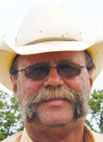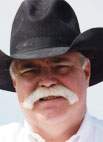Dreaming of Dexters
Spend just five minutes talking cattle with Gene Pittman and his enthusiasm about his lifelong dream becomes apparent. Gene, who has been in the area most of his life, lives on a 42-acre farm outside Tahlequah, Okla., and has been at his current residence for almost 30 years. Gene’s love of the farm life was nurtured by his grandparents; he spent as much time as possible on their farm. Today, Gene is proud to be one of the largest breeders of Dexter cattle in Oklahoma.
Love for the Land
Steve Robinson’s passion and dream was always to one day be living back at his family homestead. The family homestead has been in his family since 1864 when his great-great Uncle Harve Bruce homesteaded the land. After years of college and 20 years of teaching elementary education Steve took a huge leap of faith and headed back to the mountains of Jerusalem, Ark. For the past 4 years Steve has been a full-time farmer at his ranch-Oak Springs Mountain Ranch. The ranch located on Oak Mountain received its name from the mountain it calls home and the springs that one can find upon it. The ranch’s 411 acres is home to not only Steve and his trusty K-9 partner in crime Mandy but goats, horses, cows, dogs, chickens and lots of gardens. Steve started his ranch of diversity with the goal of one day becoming self-sufficient.
Learning By Doing
Gerry and Gail Sansing’s back property line borders on the city of Harrison, Ark. But don’t think that means they’re city folk. Gail learned 37 years ago when she married Gerry that they were definitely in the country.
It Only Takes Two
Nell and Ron Dent never really planned to raise goats, it just sort of happened. It all started when a friend who had leased the Dent’s six acres to raise his goats asked if Nell would be interested in bottle-feeding a set of orphaned twin does.
Playing with Poultry
Benjie and Cathy Stalcup, live at the end of a very interesting road, with trees that greet you with smiling faces, as you drive up the lane. At the end of the road it opens up to a very neatly kept, peaceful view of a poultry farm that Benjie runs, while Cathy works in town as plant manager of Hanes Brand, Inc. "We have been farming since 1986,” she stated, "we started with 70 acres in the beginning. Benjie and I decided that instead of moving with the company we both worked for, we would put in a laying house,” said Cathy. “I worked the laying houses for about 2 years for Tyson, while Benjie went to work helping in the start up of the rendering plant,” she replied.
Natural Hens in the Natural State
Underneath bustling traffic on Interstate 540 sits a piece of Eden in rural West Fork, Ark.
Rolling with Change
The market hogs industry has changed tremendously since the days before. No more are the days of hand feeding, carrying water and digging wallows to help keep the hogs cool on hot summer days, stated Sam McKenzie.
Traditional Ways
If you’re looking for a traditional cattle operation with a little bit of uniqueness to it, look no further than Mt. Vernon, Ark. This is the home of Jerry Henry, his family, horses and cattle business.
Providing a Profit
John and Donna Fields had a dream 21 years ago; to someday own the many acres of countryside that John played and explored on as a child growing up. The couple moved back to Jay, Okla., from Alaska in 1990 and began taking steps toward their dream. Starting with only 40 acres, John and Donna worked daily to make that dream a reality. Today, that dream is the successful 550-acre farm, Bar Circle F Ranch.
Integration – A Good Thing
For Dr. Joan Burke, research animal scientist at the USDA Agricultural Research Service and Dale Bumpers Small Farms Research Center in Booneville, Ark., finding the answer to one question fueled them. The question – if chickens could break the parasite life cycle of Haemonchus contortus or Barberpole worm to lessen the infestation rate in the stomachs of sheep and goats?











